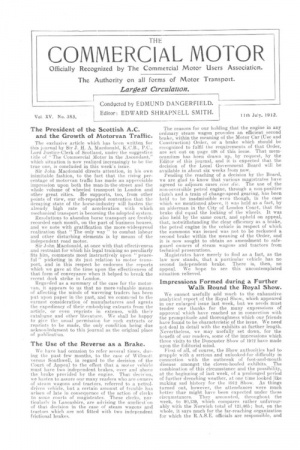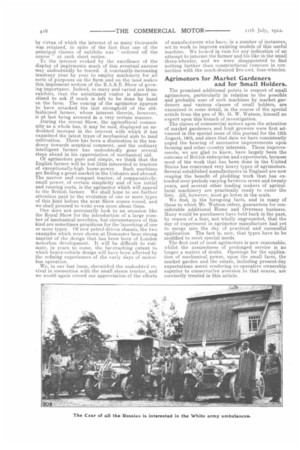The President of the Scottish A.C. and the Growth of Motorvan Traffic.
Page 1

Page 2

If you've noticed an error in this article please click here to report it so we can fix it.
The exclusive article which has been written for this journal by Sir J. H. A. Macdonald, K.C.B., P.C., Lord Justice-Clerk of Scotland, under the suggestive title or " The Commercial Motor in the Ascendant," which situation is now realized increasingly to be the true one, is concluded in this week's issue.
Sir John Macdonald directs attention, in his own inimitable fashion, to the fact that the rising percentage of motorvan traffic has made an appreciable impression upon both the man-in-the-street and the whole volume of wheeled transport in London and other great cities. He supports, too, from other points of view, our oft-repeated contention that the decaying state of the horse-industry will hasten the already high rate of acceleration with which mechanical transport is becoming the adopted system. Resolutions to abandon horse transport are freshly recorded each month, on the part of business houses, and we note with gratification the more-widespread realization that "The only way' to combat labour and other disturbing elements is by means of the independent road motor.
Sir John Macdonald, at once with that effectiveness and restraint for which his legal training so peculiarly tits him, comments most instructively upon " peaceful " picketing in its just relation to motor transport, and in this respect he endorses the reports which we gave at the time upon the effectiveness of that form of conveyance when it helped to break the recent dock strike in London.
Regarded as a summary of the case for the motorvan, it appears to us that no more-valuable means of affecting the minds of wavering traders has been put upon paper in the past, and we commend to the earnest consideration of manufacturers and agents the expediency of their embodying extracts from the article, or even reprints in extenso, with their catalogue and other literature. We shall be happy to give the usual permission for such extracts or reprints to be made, the only condition being due acknowledement to this journal as the original place
of piihlieaton. • The Use of the Reverse as a Brake.
We have had occasion to refer several times, dining the past few months, to the case of WillmoP. versus Southwell, in regard to the. decision of the Court of Appeal to the effect that a motor vehicle must have two independent brakes, over and above the brake provided by the engine. That decis'on, we hasten to assure our many readers who are owners of steam wagons and tractors, referred to a petroldriven vehicle, but a certain amount of trcuble has arisen of late in consequence of the action of clerks to some. courts of magistrates. These clerks, particularly in Lancashire, are advising the applicatOn of that, deeision in the ease of steam wagons and tractors which are not fitted with two independent frictional brakes.
The reasons for our bolding that the engine in any ordinary steam wagon provides an efficient second brake, within the meaning of the Motor Car (Use and Construction) Order, or a brake which should be recognized to fulfil the requirements of that Order, are set out on page 428 of this issue. That memorandum has been drawn up, by request, by the Editor of this journal, and it is expected that the decision of the Local Government Board will be available in about six weeks from now. Pending the reaching of a decision by the Board, we are glad to know that various magistrates have agreed to adjourn cases sine die. The use of the non-reversible petrol engine, through a non-positive clutch and a tram of change-speed gearing, has been held to be inadmissible even though, in the case which we mentioned above, it was held as a fact, by an alderman in the City of London Court, that the brake did equal the locking of the wheels. It was also held by the same court, and upheld on appeal, that, notwithstanding the clear efficiency as a brake, the petrol engine in the vehicle in respect of which the summons was issued was not to be reckoned a second brake within the meaning of the Order, and it is now sought to obtain an amendment to safeguard owners of steam wagons and tractors from technical prosecutions.
Magistrates have merely to find as a fact, as the law now stands, that a particular vehicle has no second independent brake. There is, then, no appeal. We hope to see this uncontemplated situation relieved.
Impressions Formed during a Further Walk Round the Royal Show.
We cannot usefully add much to the exhaustive analytical report of the Royal Show, which appeared in our enlarged issue last week, but we needs must tender our thanks for the many expressions of approval which have reached us in connection with the promptitude and thoroughness which our friends have found to be characteristic of the issue. We need not deal in detail with the exhibits at further length. Nevertheless, we may usefully set down, for the benefit of our readers, some of the impressions which three visits to the Doncaster Show of 1912 have made upon the Editorial mind.
First of all, of course, the Show authorities had to grapple with a serious and unlooked-for difficulty in connection with the outbreak of foot-and-mouth disease amongst the cloven-hoofed exhibits. The combination of this circumstance and the possibility, at the beginning of last week, of a prolonged period of further drenching weather, at one time looked like making sad history for the tele Show. As things turned out, however, the attendances were much better than might have been expected under these circumstances. They amounted, throughout the week, to 90,139, which compares rather unfavourably with the Norwich total of 121,465 ; but, on the whole, it says much for the far-reaching organization for which the R.A.S.E. officials are responsible, and
by virtue of which the interest of so many thousands was retained, in spite of the fact that one of the principal classes of exhibits was " ordered off the course " at such short notice.
To the interest evoked by the excellence of the display of implements much of this eventual success may undoubtedly be traced. A constantly-increasing tendency year by year to employ machinery for all sorts of purposes on the farm and on the land makes this implement section of the R.A.S.E. Show of growing importance. Indeed, so many and varied are these exhibits, that the uninitiated visitor is almost inclined to ask if much is left to be done by hand on the farm. The coming of the agrimotor appears to have attacked the last stronghold of the oldfashioned farmer, whose interest therein, however, is at last being aroused in a very certain manner.
.During the recent Show, the agricultural community as a whole has, it may be said, displayed an undoubted increase in the interest with which it. has examined the latest types of mechanical aids to land cultivation. There has been a diminution in the tendency towards sceptical comment, and the ordinary intelligent farmer has undoubtedly gone several steps ahead in his appreciation of mechanical aid. Of agrimotors pure and simple, we think that the English farmer will be but little interested in tractors of exceptionally-high horse-power. Such machines are finding a great market in the Colonies and abroad. The narrow and compact tractor, of comparativelysmall power, of certain simplicity and of low initial and running costs, is the agrimotor which will appeal to the British farmer, We shall hope to see further attention paid to the evolution of one or more types of this kind before the next Show comes round, and we shall proceed to write even more about them.
One does not necessarily look to an occasion like the Royal Show for the introduction of a large number of mechanical novelties, but circumstances of this kind are sometimes propitious for the launching of one or more types. Of new petrol-driven chassis, the two examples which were shown at Doncaster bear strong imprint of the design that has been born of London motorbus development. It will be difficult to estimate, in years to come, the far-reaching extent to which heavy-vehicle design will have been affected by the refining experiences of the early days of motorbus operation.
We, in our last issue, chronicled the undoubted revival in connection with the small steam tractor, and we would again record our appreciation of the efforts of manufacturers who have, in a number of instances, set to work to improve existing models of this useful machine. We looked in vain for any indication of an attempt to interest the farmer and his like in the small three-wheeler, and we were disappointed to find nothing further than constructional rumours in connection with the much-desired five-ewt. four-wheeler.
Agrimotors for Market Gardeners and for Small Holders.
The promised additional points in respect of small agrimotors, particularly in relation to the possible and probable uses of such machines by market gardeners and various classes of small holders, are examined in some detail, in the course of the special article from the pen of Mr. G. W. Watson, himself an expert upon this branch of investigation.
The claims of commercial motors upon the attention of market gardeners and fruit growers were first advanced in the special issue of this journal for the 12th _August, 1905, and since that date we have consistently urged the bearing of successive improvements upon farming and other country interests, Those improvements, we are glad to know, have largely been the outcome of British enterprise and experiment, because most of the work that has been done in the United States has concerned very heavy types of agrimotors. Several established manufacturers in England are now reaping the benefit of plodding work that has extended over periods varying between seven and twenty years, and several other leading makers of agricultural machinery are practically ready to enter the lists. All, however, must go lower in the scale.
We find, in the foregoing facts, and in many of those to which Mr. Watson refers, guarantees for considerable additional Home and Overseas business. Many would-be purchasers have held back in the past, by reason of a fear, not wholly ungrounded, that the day of experiment in agrimotor manufacture had yet to merge into the day of practical and successful application. The fact is, now, that types have to be modified to meet special needs.
The first cost of most agrimotors is now reasonable, whilst the assuredness of prolonged service is no longer a matter of doubt. Openings for the application of mechanical power, upon the small farm, the market garden and the estate, including present-day expectations anent rendering co-operative ownership superior to conservative aversion to that course, are succinctly treated in this article.






















